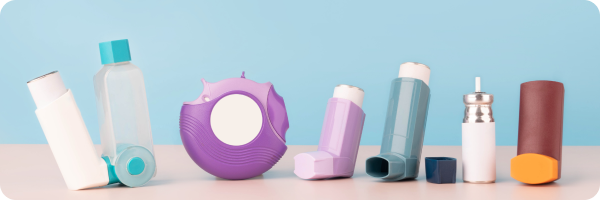Taking medication every day – especially when you feel well – can feel like a chore. But it’s actually one of the best things you can do for your lungs. From relief when you’re breathless to prevention of flare-ups, using the right medicines correctly can help you stay active, confident, and healthy for the long run.
This detailed guide explains how your medicines work, how to use them well, what side effects to watch for, and what questions to ask – all in an easy, chatty style without any medical jargon.
Why medicines matter (Even when you feel fine)
Your airways – the tubes that carry air in and out of your lungs – can stay inflamed or sensitive, even when you’re not noticing symptoms. That means things like smoke, cold air, dust, or a cold can trigger flare-ups.
Taking your medicines helps:
🧘 Calm that invisible inflammation, so flare-ups are less likely
🫁 Keep your airways relaxed, making breathing easier
🚑 Prevent flare-ups, reducing hospital visits
🛡️ Protect your lungs over time
Leading guidelines now recommend using the right medications regularly and early – rather than waiting for symptoms to show up first.
Understanding your medications: Relievers vs Preventers (and more)
To make it easier to follow, here’s some simple definitions of some of the terms used to describe respiratory medicines:
- Relievers (also called “quick-relief” or rescue inhalers): Used when you’re having symptoms — they open your airways fast.
- Preventers (often called “maintenance” inhalers): Taken every day, even on good days — they stop inflammation from building up.
- Long-acting medicines: Work over hours to keep airways open and inflammation calm — used once or twice daily.
- Triple therapy: Combines three types in one inhaler — used for more severe cases.
- bronchodilators help open up your airways (the tubes that carry air in and out of your lungs), making it easier to breathe. They work by relaxing the muscles around your airways so more air can flow in and out.
- Biologics are special medicines made from natural proteins that target specific parts of your immune system to reduce inflammation.
- Steroids (also called corticosteroids) are medicines that reduce swelling and inflammation in your airways, making it easier to breathe.
💬 Steroids used in asthma and COPD are not the same as anabolic steroids sometimes used for building muscle.
What’s right for asthma vs COPD?
| Medicine Type | Asthma (BNSSG 2025) | COPD (GOLD 2024/25) |
|---|---|---|
| ICS (inhaled corticosteroids) | ✅ Core preventer treatment (usually daily) | ⚠️ Only in people with frequent exacerbations and high eosinophils, usually combined with LABA/LAMA |
| LABA / LAMA (long-acting bronchodilators) | ✅ Add-on if not controlled on ICS alone (always with ICS in asthma) | ✅ Core treatment; used alone or combined |
| AIR/MART (ICS + formoterol) | ✅ Preferred first-line for most adults (single maintenance and reliever therapy) | ❌ Not used |
| Montelukast (tablet) | ✅ Add-on option if symptoms persist (esp. allergic or exercise-induced) | ❌ Not used |
| SABA (short-acting bronchodilators e.g. salbutamol) | 🚨 For symptom relief only; frequent use signals poor control | ✅ Occasional relief as needed |
| Triple Therapy (ICS + LABA + LAMA) | ✅ For severe asthma or asthma–COPD overlap (specialist guidance) | ✅ Standard for severe COPD with frequent exacerbations |
| Oral Steroids (e.g. Prednisolone) | ✅ Short-term during severe flare-ups only | ✅ Short-term during exacerbations |
| Biologics (injectable) | ✅ Specialist option for severe uncontrolled asthma with specific phenotypes | 🟡 Emerging, in selected severe cases |
Let’s explore each of these most commonly used medicines in more detail…

💨 ICS (Inhaled corticosteroids) – Preventer inhalers
Examples: Beclometasone (Clenil, Qvar), Budesonide (Pulmicort), Fluticasone (Flixotide)
What it is: A preventer inhaler – used daily to reduce inflammation and swelling inside your airways.
Why it matters: Helps keep your asthma or COPD stable over time, lowers the risk of flare-ups, and protects your lungs. It doesn’t give quick relief right away but works in the background to stop symptoms starting.
How it works:
- Calms inflammation in your airways.
- Reduces mucus and swelling so breathing stays easier long-term.
How to use it:
- Take it every day, even when you feel well – this is key!
- Usually taken once or twice daily.
- Always rinse your mouth after use to avoid side effects like thrush.
Common side effects:
- Hoarse voice
- Sore throat
- Oral thrush (rinsing helps prevent this)
Possible but rare issues:
- Bruising
- Slight increase in risk of infections in the mouth or throat with long-term use
Be cautious if: You stop suddenly – always talk to your healthcare professional first.
Long-acting bronchodilators (LABA/LAMA)
Examples: Salmeterol, Formoterol | Tiotropium, Glycopyrronium
What they are: Inhalers that keep airways open all day.
- LABA: usually used with preventers in asthma.
- LAMA: mainly for COPD to ease breathlessness.
How they work: Relax muscles in your airways over 12–24 hours.
How to use them:
- Take daily.
- Ask for a technique, review annually.
Side effects:
- Dry mouth
- mild constipation (especially with LAMA)
- Tremors
- Racing heart
Check with your doctor if: You have glaucoma or prostate concerns before using LAMA.
Anti-inflammatory reliever (AIR/MART – ICS + Formoterol)
Examples: Symbicort, Fostair
What it is: One inhaler combining a preventer (ICS) and a fast-acting long-lasting bronchodilator (formeterol).
Why it matters: Lets you “kill two birds with one stone” — treat inflammation and get quick relief.
How it works:
- The preventer (ICS) keeps your airways calm.
- The formoterol works fast like a reliever but lasts much longer.
How to use it:
- Use it every day, even if you’re symptom-free.
- Also use it when you feel symptoms – no need for a separate salbutamol.
Get in the habit: set a daily alarm, rinse your mouth afterward, and jot down any symptom changes.
Common side effects:
- Hoarse voice
- Sore throat
- Thrush (rinse your mouth or use a spacer)
Possible but rare issues:
- Tremor
- Headache
- Racing heart
Stick to your prescribed dose.
Be cautious if: You have severe liver disease or use another strong bronchodilator.
Montelukast (Singulair)
What it is: A daily tablet that helps reduce inflammation from allergens.
Best for: Allergic asthma, exercise-triggered symptoms, or hay fever. Not usually for COPD.
How it works: Blocks chemicals that cause swelling, mucus, and sneezing.
How to use it: Usually once each evening; test for 4–8 weeks, and stop if unhelpful.
Side effects:
- Headache
- Stomach pain
- Vivid dreams or mood shifts (less common)
Important caution: Rarely linked to mental health changes – report any mood shifts to your doctor.
SABA – Short-acting beta agonist (e.g., Salbutamol)
Examples: Ventolin, Salamol, Airomir
What it is: A quick-relief (rescue) inhaler that works fast when you’re breathing is tight.
How it works: works as a bronchodilator relaxing airway muscles within ~5 minutes.
How to use it:
- Use only when you need it.
- If you’re using it more than 2-3 times a week, something needs adjusting.
- Use a spacer if you have one.
- Not for long-term use on its own – always pair with preventer medication.
Possible side effects:
- Shaky hands
- Faster heartbeat
Triple therapy – ICS + LABA + LAMA
Examples: Trimbow, Trelegy, Trixeo
What it is: One inhaler combining all three key medicines.
When it’s used: For more severe asthma or COPD with frequent flare-ups.
How it works: Opens airways, calms inflammation, and helps control symptoms.
How to use it: Once daily, rinse your mouth. Keep at the same time.
Considerations: Slightly higher risk of pneumonia in COPD. Watch for combined side effects.
Oral steroids (Prednisolone)
What it is: A strong steroid tablet used for flare-ups.
How it works: Slashes inflammation fast when your symptoms get serious.
How to take it: Typically 30–40 mg for 5–7 days, in the morning, with food.
Side effects (especially with repeated use):
- Weight gain
- Insomnia
- Mood swings
- High blood pressure
- Weak bones
Use carefully: Long-term use only under specialist care.
Biologics (Injectables for severe asthma)
Examples: Omalizumab, Mepolizumab, Dupilumab
What they are: Advanced injections given by a specialist.
Who they’re for: People with severe, uncontrolled asthma with specific immune triggers.
How they work: Target the immune system’s pathways that cause flare-ups.
How they’re given: Every 2-8 weeks, at clinic or at home. Only available after tests and specialist referral.
Side effects:
- Injection site reactions
- Mild flu-like symptoms
- Possible eye issues
Spacer use = Better medicine delivery
If you have a puffer (pressurised inhaler), a spacer is a plastic tube that makes breathing in medicine easier and more effective.
- Helps more medicine reach your lungs
- Reduces throat irritation and hoarse voice
- Highly recommended for MDIs, especially in children
Correct inhaler technique = Better control
Using the correct technique is just as important as taking the medication.
Even people who’ve been on inhalers for years often use them incorrectly. This means less medicine reaches your lungs – and symptoms may continue.
✅ Ask your nurse or pharmacist to check your technique
📱 Or watch inhaler-specific videos online:
RightBreathe Inhaler Technique Videos (NHS)
Other medications and treatments you may come across
Theophylline
What it is: A type of oral bronchodilator tablet that helps relax the muscles around your airways, making breathing easier.
When it’s used: It’s less commonly used nowadays because it has more side effects and needs careful blood level monitoring. It may still be offered if other inhalers aren’t enough or aren’t tolerated.
Key points: Regular blood tests are needed to keep levels safe. Common side effects include nausea, headaches, and heart palpitations.
Nebulisers
What they are: Machines that turn liquid medicine into a fine mist you inhale through a mask or mouthpiece.
When used: Mostly for severe flare-ups (exacerbations) in hospital or at home in advanced COPD. Not usually needed for routine asthma management.
Key points: They deliver high doses of bronchodilators or saline directly to the lungs. At home, they’re usually reserved for people who struggle with inhalers even after training.
Oxygen therapy
What it is: Extra oxygen given through a nasal tube or face mask to help with very low blood oxygen levels.
When used: In severe COPD or during an acute asthma attack when oxygen levels drop dangerously. Long-term home oxygen is sometimes used for advanced COPD, assessed carefully by specialists.
Key points: Oxygen is a medicine – using it without proper assessment can be harmful, especially in COPD. Your oxygen levels are checked first (e.g., with a blood gas test).
Antibiotics
What they do: Treat or prevent infections that can worsen asthma or COPD symptoms (like chest infections).
When used: Only when there’s clear evidence of a bacterial infection (e.g., worsening sputum that’s yellow or green, fever, more breathlessness).
Key points: Not all flare-ups need antibiotics – viruses are more common triggers. Overuse can lead to resistance and side effects.
Bronchial Thermoplasty
What it is: A specialist hospital treatment for severe asthma that doesn’t respond to usual medicines. A small heated device is used via a bronchoscope (a tube down your airways) to reduce the amount of smooth muscle in the airways.
When used: Only in selected severe asthma patients under specialist care, and after all other treatments have been tried.
Key points: Can help reduce severe asthma attacks and improve quality of life in some people. It isn’t used in COPD.
Why adherence matters (and How to make it easier)
Your medications work best when taken consistently. It’s common to forget doses – especially if you’re feeling well. But regular use builds long-term protection. Skipping doses puts you at risk of :
- Inflammation creeping back
- Flare-ups becoming more likely
- Hospital trips and stays
- Declining Lung function
Behaviour change research shows habits are easier to stick to when:
- You tie them to something you already do (e.g. “I take my preventer after brushing teeth”)
- You set visual reminders (e.g. sticky note or app alert)
- You track your use
The Evergreen Life app can help you manage your medications more easily, with a built-in medication diary and reminders – so you can get notification alerts to take your medicines at the right time. Learn more about how the app can support your medication management.
What to ask at your annual review
Bring your questions and concerns. Reviews are your time to get clear on your condition. You might ask:
- Is my inhaler technique still correct?
- Am I taking the right dose for my symptoms?
- Do I need a spacer?
- Have I needed oral steroids or antibiotics in the past year?
- What can I do to reduce flare-ups?
- Do I need an updated asthma/COPD action plan?
Emergency & safety reminders
- Severe symptoms like blue lips or confusion? Call 999 now.
- Changing mood on Montelukast? Report via MHRA Yellow Card.
- Never stop or change medications without talking to your healthcare team.
Key takeaways
- Daily medicines build your lung’s resilience.
- Learn what each medicine does and use them correctly.
- Regular checks, reminders, and planning help you stay in control.
- You’re empowered – ask questions and make your treatment work for you.
✅ If you haven’t already, download the free Evergreen Life app to track your health, including managing your medications, and get practical tips that help you take control of your overall health.
This article is for general educational purposes only and is not a substitute for personalised medical advice, diagnosis, or treatment. It is intended to support patient understanding and empowerment in partnership with qualified healthcare professionals.
All information is based on current UK national guidelines including the BNSSG Adult Asthma Guideline (2025), BTS/SIGN Asthma Guideline (2024), GOLD COPD Report (2024/25), and other evidence-based sources such as the MHRA, GINA, and Asthma + Lung UK. Links to these resources are included throughout the article and in the reference section.
Always consult your GP, asthma/COPD nurse, or respiratory specialist before starting, stopping, or changing any treatment.
If you experience severe breathlessness, chest pain, confusion, or blue lips or face, call 999 immediately.
Medication risks and side effects listed in this guide are not exhaustive. Individual responses may vary, and some treatments may be contraindicated based on your personal medical history, current medications, or test results. You should not delay seeking professional advice based on the content of this article.
This content is not intended to diagnose, cure, or prevent any disease and is not a medical device. It has been developed in line with MHRA guidance to remain within the scope of health education and lifestyle support.
- BNSSG Adult Asthma Guideline 2025
- BTS/SIGN Asthma Guidelines 2024
- GINA Asthma Strategy Report 2025
- MHRA Montelukast Safety Alert
- Asthma: diagnosis, monitoring and chronic asthma management (BTS, NICE, SIGN) – NG245
- NICE COPD in over 16s: Diagnosis and Management (NG115).
- Global Initiative for Chronic Obstructive Lung Disease (GOLD) 2024.
- Asthma + Lung UK Inhalers and Spacers.
- NHS Biologics for Severe Asthma.
- RightBreathe NHS-approved inhaler videos.





